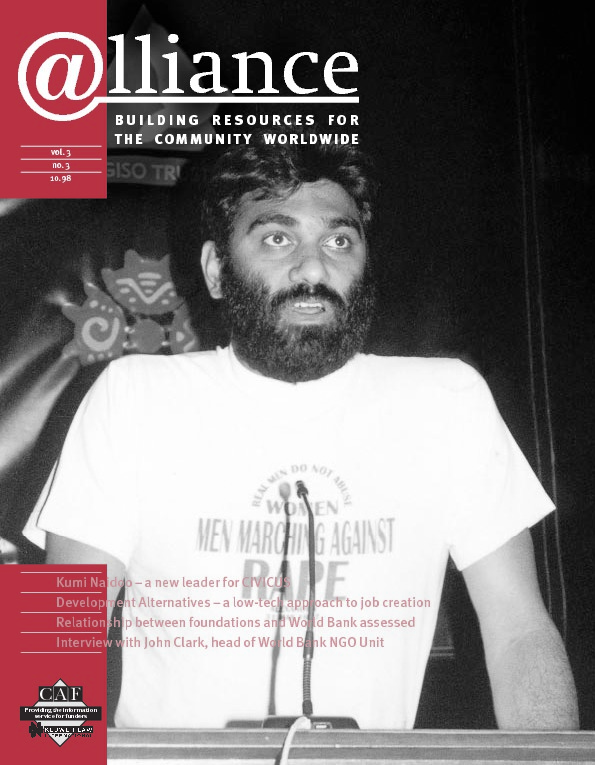Donor agencies that wish to support sustainable development in a country like India face a bewildering array of choices. Without some understanding of the context to inform their decisions, they may end up supporting programmes that actually have a negative impact on the most vulnerable groups in society.
Three fundamental issues face donors in India:
- the need for effective interventions that tackle the causes, not merely the symptoms, of poverty;
- the need to reconcile the mandates of donors with the needs of the people, expressed at community level;
- the need to combine the strengths of traditional development practices with more innovative approaches to ensure sustainable and equitable models of development.
With the reality of globalization breaking down the barriers to free flow of capital, goods, services and information, the prevailing emphasis is on growth rather than growth with equity. But economic growth does not necessarily benefit the large number of people living in poverty. The hopes of positive ‘trickle-down’ effects for the poor resulting from structural adjustment programmes have been emphatically disproved. These globalizing trends, where the poor are not in a position to exploit opportunities in the marketplace, can result in a greater struggle for equal access to, and distribution of, resources.
The official poverty estimates are themselves contentious. Poverty is officially defined as lack of adequate income to provide individuals living in rural and urban areas with a daily calorie intake of 2,400 and 2,100 respectively, but this definition fails to capture aspects relating to health and literacy and less tangible dimensions of poverty such as loss of capability, vulnerability and powerlessness. These latter factors arise because of unequal relationships between women and men within the household, the community, and the formal and informal economy, and inequitable relationships between caste, class and minority social groupings. It is therefore crucial that intervention strategies should not serve to strengthen particular groups (for example men and upper-caste communities) over those of others.
At the macro level, a capital-intensive approach to agriculture and the creation of large-scale irrigation, power, industrial, mining and urban development projects have progressively marginalized and displaced a large number of families from land and livelihood. At the same time an increasing number of low-wage, low-productivity jobs have been generated in the informal sector as subcontractors seek to bypass the unionized labour force in order to reduce costs and increase competitiveness. In the past three years an average of 6.5 million new jobs have been created in India, almost 90 per cent in the informal sector. In many cases women are taking up these jobs as employers find it easier to deny them fair conditions.
Liberalized industrial and trade policies also pose certain challenges to traditional non-farm livelihoods such as fisheries and handloom weaving. Re-establishing sustainable markets and enabling small artisans to access local and international markets is emerging as a critical need. Other macro development trends have a wider impact. The cultivation of cash crops at a local level has had an impact on the price of food and consumption levels of the poor. The loss of income can often lead to additional work burdens for women and children – girls in particular.
New windows of opportunity
Despite the threats there are always new windows of opportunity for addressing poverty. A number of concrete changes currently in place, which need further strengthening, are giving some hope for the future:
- New legislation gives legal status, responsibility and some degree of financial autonomy to village and other local democratic structures. Capacity-building initiatives to support the development of local-level planning is critically needed to promote community-led social change.
- Successive recent governments have established institutions to protect and promote the interests of particular groups, and the poor in general. These include Consumer Protection Courts, the National Commission on Women, the National Human Rights Commission, and state-level Disaster Preparedness Training Centres.
- Increasingly national NGOs are developing their own local communication and fundraising strategies. The goal of such activities is not simply to raise local funds for their future work. The aim is also to mobilize public opinion on social issues and poverty, give the public more options for influencing social change, and rekindle the spirit of voluntarism in India. There is evidence that communicating about the ‘harder’ issues in development (bonded labour, empowerment of marginalized groups, child labour) does result in great public support and interest. Such NGO activities need support and strengthening.
- There are a growing number within the corporate sector who are keen to demonstrate social responsibility. Whether by building sustainable partnerships with NGOs or by promoting internal social audits and ethical practices, the corporate sector has the potential to play an important role in community development. There is an opportunity here for other donors to help realize this potential by bringing companies into development partnerships.
Finding the right partner
Many donors, both traditional and new, have come to India. India has been experiencing increased flows of foreign aid (recent political events notwithstanding). Bilateral agencies are increasingly open to direct funding of NGOs. Yet finding the right NGO partners is not an easy or straightforward matter.
The non-profit sector in India has been engaged in a wide spectrum of activities, from providing services themselves to encouraging vulnerable groups to articulate their own alternative development models and approaches. NGOs in India have a vital role to play in articulating the voices of those who experience social, economic and cultural exclusion. There are also increasing trends towards collaboration within the Indian non-profit sector to secure places at national and global forums in order both to network with organizations with similar interests and to lobby more effectively on issues related to poverty and development.
Increasingly NGOs are orienting their strategy towards the efficient delivery of services through community participation, with greater emphasis on developing technical capacities in certain sectors (for example wasteland development or income generation programmes). There are many examples of NGOs adopting low-cost and effective approaches which demand local action. (Because of their small size and local nature, however, these are not easily amenable to scaling up.)
Donors should support those NGOs that are working to strengthen people’s organizations (especially those of poor people), to enhance their ability to challenge social hierarchies, and to increase the opportunities of currently excluded groups (Dalits, tribals, women, etc) to play a real part in development planning.
The following are some of the key questions for donor agencies wishing to support development in India to ask about prospective partner NGOs:
- How sensitive to gender and equity issues are the prospective partners? How do they assess gender and equity perspectives when addressing impact?
- Do they involve the communities with whom they are working in strategic planning, appraisal and monitoring processes?
- What external analyses of the dynamics of poverty do they use to assess its differential impact on different vulnerable groups?
- How can the issue of avoiding dependency be approached sensitively?
- An increasingly important role has been played by academic and research institutes, which have been carrying out pioneering work on poverty-related issues. This has created a substantial body of knowledge and expertise for NGOs and other organizations to draw upon. Supporting the public debate on development and poverty issues is another valuable role for donors.
A lack of donor coordination
Although there are so many donors active in India, they tend not to act in any coordinated way. Joint action among donors and concentration of efforts in the same priority areas could greatly facilitate the development of capacity among the poor. Funders could work together to develop more consistent strategies and people-centred development models.
The lack of donor agency coordination, the increased availability of funds and therefore of fund-seeking NGOs, the emphasis placed by some donors on meeting funding disbursement targets, and the occasional lack of attention to quality and accountability that results can sometimes lead to a situation where the needs of the donor to donate funds become greater than the needs of the people who are supposed to benefit. After a disaster, for example, insensitive and excessive pumping of money to the affected area has occasionally encouraged new NGOs to spring up, subsequently diverting funds from more local, traditional and established community-based organizations that might have organized the reconstruction and rehabilitation process in a way that was more sensitive to the real needs of all in the community.
Where attempts have been made to initiate better donor coordination, the added value of such coordination has been immediately evident: donors have understood each other’s focus areas and priorities better, shared experiences and concerns on development issues, initiated joint studies and workshops to maximize resources, co-funded some programmes, such as the preparatory processes for the Beijing Conference on Women, and explored ideas for collaborative action.
Reconciling different agendas
Effective development takes place within a strong representative civil society incorporating institutions that are accountable to the people. A key question must be how closely the donor’s mandate relates to people’s needs.
The needs of the most vulnerable have always been clear: productive assets, food security, a balanced ecological environment, biodiversity, communal harmony, equity in resource distribution, equitable gender relations and planning perspectives. Yet unresolved development agendas and the conflicting mandates of different actors pull people in contradictory directions: for example, the non-profit sector may be promoting the revitalization of traditional, low-cost, high-impact water management systems while multilateral and bilateral donors aim to build high-cost, energy-dependent systems that rely on the introduction of unaffordable user fees.
For current and potential funders seeking to make decisions about how best to use their resources, there is still no better place to begin than by applying the simple principle with the greatest amount of integrity – ask the people.
John Gwynn is National Director of Oxfam (India) Trust.
For more information about the Oxfam (India) Trust, e-mail jgwynn@oxfam.org.uk






Comments (0)